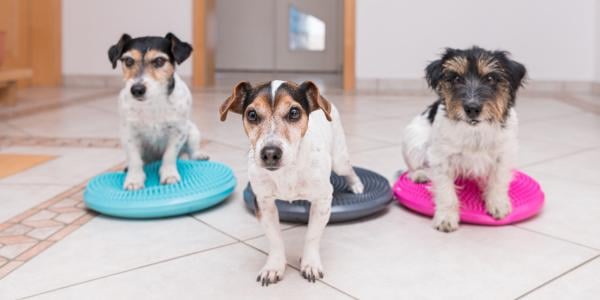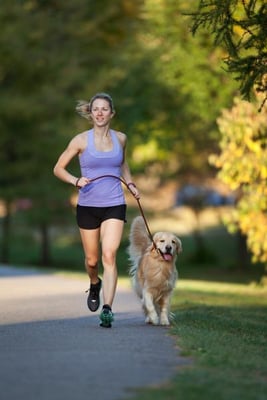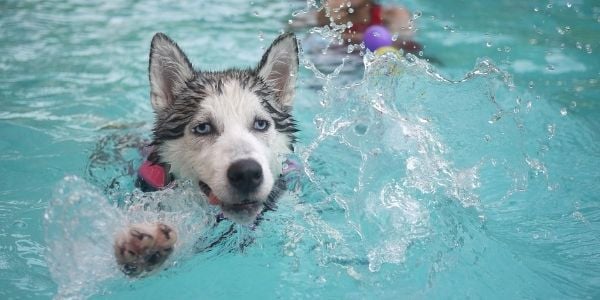 We’ve likely all experienced our dogs having boundless energy and an insatiable desire for playtime. But have you ever wondered just how much exercise your dog really needs to stay happy and healthy?
We’ve likely all experienced our dogs having boundless energy and an insatiable desire for playtime. But have you ever wondered just how much exercise your dog really needs to stay happy and healthy?
It can be tough to strike the right balance between enough exercise and too much, especially when you're juggling work, family, and everything in between.
But exercise – both physical and mental exercise – is essential for your dog’s health and behavior.
Too little exercise and your dog can become overweight or engage in boredom behaviors like digging or destructive chewing. Too much exercise and your dog may suffer muscle strain, injury, or behavioral issues like hyperactivity or restlessness.
The general rule is that dogs need between 30 minutes to two hours of exercise every day. But that's a pretty big range! And what about how much exercise puppies need compared to senior dogs? Pugs versus Huskies? There are a lot of variables. Let's dive into the different factors so you can better understand how much exercise your dog needs.
Table of Contents
What Determines How Much Exercise Your Dog Needs
There isn’t a nice chart or calculator that breaks down exercise needs because there are quite a few variables to consider:
Age: Puppies have developing bones and bodies and should not engage in high-impact activities for extended periods. On the other hand, adult dogs generally require more exercise to maintain their health and energy levels. Senior dogs may have exercise limitations due to age-related conditions or mobility challenges.
Breed and Size: Different breeds have varying energy levels. Understanding your dog’s breed plays a big part in knowing how much exercise is ideal. Even though both Bulldogs and Border Collies are considered medium-sized breeds, they have significantly different exercise needs and heat tolerances.
High-energy breeds like Border Collies, Siberian Huskies, or Jack Russell Terriers may need more exercise to satisfy their needs. Compare this to a Pug, Chihuahua, or Greyhound, who may have lower exercise requirements. (You may be surprised to see me add Greyhounds to that list of lower-energy breeds, but they can be the quintessential couch potatoes if they get some sprinting in each day.)
But even dogs within the same breed may have individual differences in how much exercise they need to thrive. Every dog is their own unique self!

Health Condition: Dogs with certain health conditions may have limitations on the amount, intensity, and type of exercise they can handle. For instance, dogs who suffer from arthritis, obesity, or heart conditions may require modified exercise routines to avoid exacerbating their condition or putting them at higher risk.
Consulting with a veterinarian or canine rehabilitation specialist can help determine the appropriate exercise plan for dogs with specific health considerations or when recovering from injury.
Personality and Behavior: Some dogs are naturally more active and have higher exercise needs, while others are more relaxed and require less activity. Understanding your dog's specific temperament and behavior can give you insights into their exercise needs.
How Much Exercise Does a Puppy Need?
This is a highly debated topic and the only thing that veterinarians, breeders, and trainers can agree on is that it is just as bad for puppies (up to 6 months old) and juvenile dogs (between 6 months to 12 months old) to get too much exercise as it is to not get enough. While most would likely never consider a long walk with a small-breed puppy, larger puppies may seem like they can keep up on longer treks. However, studies indicate too much exercise for large or giant breed dogs can cause orthopedic issues.
Is "5 Minutes Per Month of Age" Enough Exercise for Puppies? No.
This recommendation is all over the internet for how much exercise puppies need. But it simply isn't based on any scientific study. It sounds like a great rule of thumb, but every puppy is unique and has different factors to consider.
Plus, when you think it through, that means a 5-month-old puppy would only need 25 minutes of exercise a day ... you will quickly find out that it's not enough.
Young puppies under 16 weeks of age need limited exercise spread out over multiple play sessions each day. Follow the puppy's lead. Play and enrichment games are the best way to give your puppy exercise and increase movement, rather than repetitive movement activities such as walking. Plus, until certain vaccinations are finished, you can't just take your puppy outside of your home for leashed walks anyway.

Work your puppy's exercise in around their nap schedule, as sleep is crucial to proper development and learning. More exercise is required as puppies age beyond 16 weeks old, depending on the breed, but the type of safe exercise varies based on their particular growth rate. One of the best ways to exercise a puppy who has completed all of their vaccines is to go on sniffari and let them follow their nose.
Know as much as possible about your puppy’s breed and how fast they grow to help you determine their exercise needs and limitations. Do they grow quickly but mature slowly (such as large and giant breed dogs)? Or do they mature quickly and require different feeding schedules (such as toy breeds)?
Then there are those breeds whose need for mental stimulation rivals their need for exercise. Growth and maturity rates, feeding schedules, and the need for extra mental stimulation impact the amount and frequency of exercise a puppy needs.
The important thing is to gradually build up your puppy’s exercise time and follow your puppy’s lead when on walks or during other activities. Be sure to give them a lot of breaks, even if they try to make you think they are just fine, to avoid wearing them out or causing injury.
How Much Exercise Does an Adult Dog Need?
An important part of maintaining an adult dog’s health and preventing obesity is making sure they are getting adequate exercise. As with puppies, there is no one-fits-all answer to how much exercise an adult dog needs. A good rule to follow is 30 minutes to 2 hours per day, depending on the factors described above and the individual needs of your dog.
Regardless of your dog’s size, the bare minimum amount of exercise per day you should give them is 30 minutes. But it is important to adjust that duration to meet your dog’s needs, which may be considerably longer.

How Much Exercise Does a Senior Dog Need?
Even though the type and duration of exercise may need to change, exercise is still essential for senior dogs to maintain their health and behavioral well-being.
Your senior dog should get at least 30 minutes of exercise per day. This can be broken up into two to three sessions. Aim for low-impact exercises and be sure to change up their routine, including activities that also provide mental stimulation, such as scent work.
If you and your senior dog want to increase the daily duration, do so gradually, such as adding 5-minute intervals per day. It is important that you monitor your dog for any signs of discomfort or pain. If notice signs of discomfort or pain, be sure to allow for rest and recovery and then return to the daily duration they were comfortable with.
What Happens if Your Dog Doesn't Get Enough Exercise?
If you notice your dog exhibiting any of the following, then they may not be getting enough exercise. It's important to note that these signs can also indicate other underlying health issues, so it's crucial to consult with a veterinarian to rule out any medical conditions.
- Weight gain: If you notice that your dog is putting on extra pounds, it may be a sign that they aren't getting enough exercise. Regular physical activity helps dogs burn calories and maintain a healthy weight. However, there are more things you can do to help your dog lose weight beyond increased exercise.
- Destructive behavior: Dogs that are bored and don't get sufficient exercise may engage in destructive behavior, such as chewing on furniture, shoes, or other household items. Exercise helps channel their energy in a productive way and reduces their tendency to be destructive.
- Restlessness: Dogs that don't get enough exercise may appear restless or display signs of excessive energy. They may pace around the house, have difficulty settling down, or seem constantly on edge.
It’s important to note that sometimes restlessness may indicate another problem, such as separation anxiety. If your dog only exhibits restless behavior when you leave, then connect with a certified canine behavior consultant to address potential separation anxiety. Learn more about separation anxiety in dogs here. - Sluggishness or depression: On the flip side, some dogs may become lethargic, disinterested, or exhibit signs of depression when they aren't physically active enough. Regular exercise helps keep their bodies and minds stimulated, contributing to a more positive and energetic demeanor.
- Excessive barking: Lack of exercise can contribute to excessive barking in dogs. When dogs are bored or have pent-up energy, they may bark excessively to release that energy or seek attention.
There are many reasons dogs bark, and while increasing exercise and enrichment is a part of treatment for all types, it’s important you dig deeper into the why of your dog’s barking. Learn how to stop your dog’s barking here.
Different Types of Exercise for Dogs
Daily Dog Walks
Regular walks are an essential form of exercise for dogs. Walking provides both physical exercise and mental stimulation as dogs explore their surroundings, encounter new scents, and socialize with other dogs and people.
But walks don’t have to be just point A to point B at a fast clip – and they shouldn’t be just that! Make sure to include lots of time for sniffing or set aside some walk time to let your dog enjoy a sniffari. I highly recommend walking your dog on a long leash if it’s safe in your environment because it allows more freedom of movement, which then means they get more steps in!
And if your dog is leash reactive and walks are stressful, don’t worry! It’s okay to skip walks and substitute other at-home exercises (or rent out a Sniffspot to play fetch and get a sniffari in) while you work with a professional dog trainer to address their leash reactivity.
Running and Jogging
For high-energy dogs and those who require more intense exercise, running or jogging can be beneficial. This type of exercise helps burn off excess energy and can be a great way to bond with your dog.
But don’t just strap on your running shoes and take your dog for a run without some preparation and conditioning training!
Learn more about how to train your dog to run with you here.
Fetch
Playing fetch is a classic game that provides both mental and physical exercise. It engages dogs in running and retrieving objects, stimulating their natural instincts and helping them burn energy. However, it’s important to be aware of the potential pitfalls of excessive fetch and both acute and chronic injuries that can occur (see below).
Is your dog not so sure how fetch works? Learn how to teach your dog to fetch.
Playing with a Flirt Pole
A flirt pole is an increasingly popular way to provide exercise and meet your dog’s need to chase and catch a toy. A flirt pole is basically a cat wand type of toy but is designed to be larger and sturdier for use with dogs.
As with fetch, flirt pole play is not meant for long periods of use at one time. Instead, it’s perfect for 2 to 3 minutes before a walk or prior to guests coming over (to take the edge off).
Safety Note: High-energy activities such as fetch or playing with a flirt pole, can result in acute minor injuries such as torn toenails, or more serious ones, such as muscle or tendon strains/tears or broken bones. Any of these result in significant pain and lameness.
Though they may appear acute, cranial cruciate ligament (CCL) tears can occur because of long-term degradation from the repetitive and high-impact movements that can be involved in fetch. They appear suddenly due to abrupt lameness and pain.
The continuous and sudden movements as well as sharp and hard turns can result in a spinal disc bulging or rupture. Dogs can have sudden weakness or paralysis of their hind end.
These types of activity can, over time, cause the progression or worsening of osteoarthritis. Steps must be taken to manage this condition.
Swimming
Swimming is a low-impact exercise that is great for dogs, particularly for those with joint issues or physical limitations. It provides cardiovascular benefits and is gentle on the joints. However, not all dogs enjoy or are suited for swimming, so it's important to gradually introduce them to water and ensure their safety.
Learn more about teaching your dog to swim here.

Agility Training
Agility training involves navigating through obstacle courses, jumps, tunnels, and ramps. This not only provides physical exercise but also challenges dogs mentally and helps improve their coordination and problem-solving skills. It’s also a great way to get yourself moving, as you have to run alongside and help your dog navigate the course.
Agility training should be done in incremental steps, focusing first on building basic foundations and movements before attempting more difficult obstacles or higher jumps. It’s best to work with a professional agility trainer to make sure your dog is learning how to safely navigate each obstacle type to avoid injury.
Hiking
 Hiking can be an excellent exercise option for dogs that love exploring new environments and staying active. It offers a combination of physical activity and mental stimulation with different sights, scents, and terrains to experience.
Hiking can be an excellent exercise option for dogs that love exploring new environments and staying active. It offers a combination of physical activity and mental stimulation with different sights, scents, and terrains to experience.
Just as with running, you’ll want to help your dog build up endurance before going on more challenging hikes, and you’ll need to take extra precautions with their paw pads when hiking on trails.
Get loads of tips for hiking with your dog here.
Interactive Dog Toys and Puzzle Games
Certain toys and puzzle games can provide excellent enrichment and keep your dog mentally active. Working their brain burns energy, too!
Different interactive feeders for dogs require problem-solving skills, challenging them to find treats or figure out how to access rewards. This satisfies their instinctual desire to forage (and work) for food! Make every mealtime an enrichment activity to help prevent boredom and provide exercise for your dog.
Check out my favorite interactive dog puzzles and feeders here, along with extra tips on how to successfully introduce them to your dog.




